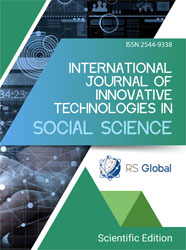IDENTIFYING LEARNERS LEARNING STYLES USING THE VARK MODEL
Abstract
Understanding students' learning styles and personality traits is essential for creating effective learning strategies tailored to their needs and enhancing their ability to learn independently. Learning styles encompass various aspects of human cognition, perception, behavior, and cognitive traits that influence how students acquire, process, and retain information.
To enhance the efficiency and effectiveness of educational interventions, educators must grasp each student's learning style and select teaching approaches that align with their individual characteristics. This not only enhances academic performance but also fosters student engagement, participation, and collaboration.
While numerous learning style frameworks have been proposed in research, the VARK model (Visual, Auditory, Read/Write, Kinesthetic) stands out as a widely utilized, practical, and easily applicable model. According to the VARK model, students are categorized into visual, auditory, reading/writing, and kinesthetic learners based on their preferred mode of information intake.
This research aims to identify students' learning styles, evaluate their impact on academic success, and explore avenues for optimizing instructional practices and enhancing learning outcomes.
References
Bandura, A. (1986). Social foundations of thought and action: A social cognitive theory. Prentice Hall.
Bruner, J. S. (1966). Toward a theory of instruction. Harvard University Press.
Caine, R. N., & Caine, G. (1997). Education on the edge of possibility. Association for Supervision and Curriculum Development.
Chapter 1 ready to learn and learning style inventory. (2018, July 28). Itha Lis Asyamimi. https://ithalisasyamimi.wordpress.com/2018/07/28/chapter-1-ready-to-learn-and-learning-style-inventory/
Fleming, N. D. (2001). Teaching and learning styles: VARK strategies. Neil Fleming.
Gardner, H. (1993). Multiple intelligences: The theory in practice. Basic Books.
Google. (n.d.). https://www.google.mn
Gogo.mn. (n.d.). https://gogo.mn/r/en3wm
Kandel, E. R. (2006). In search of memory: The emergence of a new science of mind. W. W. Norton & Company.
Kolb, D. A. (1984). Experiential learning: Experience as the source of learning and development. Prentice Hall.
Learning.mn. (2025, May 6). https://learning.mn/2025/05/06/%D1%81%D1%83%D1%80%D0%B0%D0%BB%D1%86%D0%B0%D1%85-%D1%85%D1%8D%D0%B2-%D0%BC%D0%B0%D1%8F%D0%B3-%D0%B3%D1%8D%D0%B6-%D1%8E%D1%83-%D0%B2%D1%8D/
Ng, J. (2025, January 3). VARK learning styles. AhaSlides. https://ahaslides.com/mn/blog/vark-learning-styles/
Piaget, J. (1977). The development of thought: Equilibration of cognitive structures (A. Rosin, Trans.). Viking Press.
Sperry, R. W. (1981). Some effects of disconnecting the cerebral hemispheres. Science, 217(4566), 1223-1226. https://doi.org/10.1126/science.7112125
Surgalt.mn. http://buteel.surgalt.mn/
VARK Learn. (2024). What does effective teaching look like? https://vark-learn.com/what-does-effective-teaching-look-like/
Vygotsky, L. S. (1978). Mind in society: The development of higher psychological processes (M. Cole, V. John-Steiner, S. Scribner, & E. Souberman, Eds.). Harvard University Press.
Views:
1167
Downloads:
935
Copyright (c) 2025 Tsevelmaa Demberel, Ulziihuyag Baasanjav

This work is licensed under a Creative Commons Attribution 4.0 International License.
All articles are published in open-access and licensed under a Creative Commons Attribution 4.0 International License (CC BY 4.0). Hence, authors retain copyright to the content of the articles.
CC BY 4.0 License allows content to be copied, adapted, displayed, distributed, re-published or otherwise re-used for any purpose including for adaptation and commercial use provided the content is attributed.











